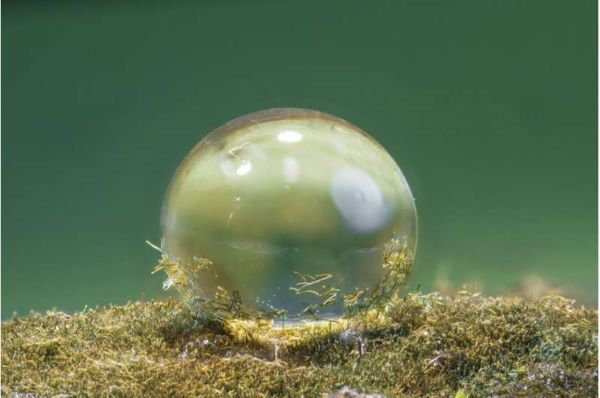|
July 2022 |
| Discovering Superhydrophobicity in the Palezoic Era |
|
We've addressed the marvels of
superhydrophobicity many times in the column. We've discovered myriad
examples of superhydrophobic surfaces found in nature - from the
Lotus leaf to the Namid Desert beetle. And we've studied the
hierarchal structures found in nature in order to better appreciate
the multitude of bioinspired manmade nanostructured surfaces which exhibit similar
super high contact angles with liquid droplets in the Cassie-Baxter
state. However, until recently, we have not contemplated what effect superhydrophobicity may have had on the development of the earth and early living matter in the neighborhood of a billion years ago to 400 billion years ago. Researchers in Germany have detailed how superhydrophobicity likely assisted in the evolution from water-based bacteria to algae and slime molds to more complex land-based plants like ferns and mosses.1 At the Botantical Garden at the University of Bonn, for example, researchers have successfully grown a highly water-repellent cyanobacterial film called Hassalia, a type of biofilm that may date back one billion years or more. See image below. It's now believed that superhydrophobicity played a key role as bacteria evolved into various forms of terrestrial growth. The German researchers, led by Wilhelm Barthlott, discovered that when the biofilm dries out on land, it can become stably superhydrophobic for life. This feature permits the transition from water to land. The main role water repellency plays in the evolutionary process is to guard against water loss, a necessity for life.
It's proposed that high water repellency at that crucial interface with the environment coupled with the self-cleaning nature of superhydrophobic surfaces may have assisted primitive bacteria and algae evolve from water-based organisms to land-based growth. This leads us to better appreciate the role non-wetting surfaces may have played during early days of the earth's development. In a similar vein, we gain a greater appreciation for today's nanostructured bioinspired surfaces that seek to emulate the qualities of organisms that are a billion or more years old. Notes |
|
|
|
FOR IMMEDIATE RELEASE SUCCASUNNA, NJ, June 21, 2022 - ramé-hart instrument company announces a new spinneret product. Over the past decade ramé-hart, the world leader in custom spinnerets, has fabricated at their New Jersey facility thousands of custom and prebuilt coaxial, triaxial, and quadaxial needles. Based on extensive customer feedback, ramé-hart has developed a new design, the Custom Coaxial Needle with Tubing, which adds flexibility for users. In lieu of the traditional female Luer fittings on the two inlets, tubing fittings are used which connect to the very popular 1.5mm ID PTFE Tubing. An option is available to convert the inner flow fitting from a tubing fitting to a female Luer connection in the event the user wishes to connect the inner flow directly to a syringe. Much like the Custom Coaxial Needle product, needle gauges and dimensions are user specified. A number of additional options are available. A new worksheet has been developed for the Custom Coaxial Needle with Tubing which can be found, along with ordering instructions, on the www.customspinnerets.com website: go to Products, then Coaxial Needles page, then go to Box 3. Like the other custom spinnerets sold by ramé-hart, this new product can be configured and ordered online. And much like the other customs spinneret products, fabrication time is one week or less. The product can be shipped to any address in the world. About ramé-hart
instrument co.
How to Save
Contact Details |
|
Regards,
Carl Clegg |


